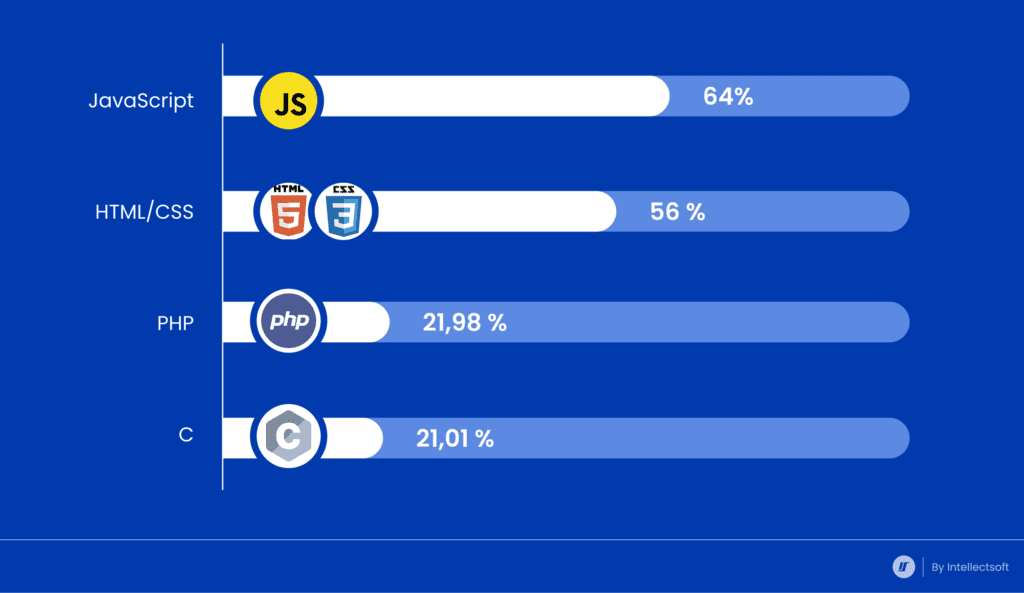The diversity of languages most commonly used among software developers is still vast. As Statista states, one in five developers uses at least one of 12 different programming languages, ranging from JavaScript (64%) and HTML/CSS (56%) to PHP (21.98%) and C (21.01%).

Diversity of languages used by software developers remains vast. According to Statista, one in five developers uses at least one of 12 different programming languages, ranging from JavaScript (64%) and HTML/CSS (56%) to PHP (21.98%) and C (21.01%).
In such circumstances, staying up-to-date with software development trends is a major part of being a good programmer, and it is important to follow the most popular backend frameworks that developers use and quickly adapt to new demands.
This article covers 7 popular backend frameworks in 2024, along with some useful tips on which might be right for you based on your experience level and other factors.
What Are Backend Frameworks?
Essentially, a backend framework provides a standardized reusable structure for creating applications. The framework can accelerate development by offering ready-made solutions for common tasks, such as database connections or user authentication.
Just like WordPress or Drupal can simplify the website creation process, a backend framework makes it easier to quickly build complex applications.
Why Use Backend Frameworks? Their Importance
Developers can use frameworks to save time when building new software. Moreover, a backend framework provides the architecture that encompasses all the necessary components for your platform, enabling the web service.
When you think about what’s needed to develop each part of a web service on your own, it’s easy to understand why so many companies choose to use these technologies. The list of the most popular backend frameworks has emerged as a result of frequent use of 7 approaches to software architecture that have proven to be effective and flexible by 2024.
7 Most Popular Backend Frameworks in 2024
There are several different types of frameworks available for developers across various platforms like .NET, Java, Python, and Ruby. The choice of which works best for your business depends on its specific needs at any given time.
For example, some platforms offer more flexibility to apply different features to different applications. Other considerations may include how large your organization is and how much support each provider offers. You might also want to check if your current team uses a specific programming language or not, so the framework you choose is relevant and can be adopted.
When you review these factors, you should have a better idea of which direction you want to take when choosing the appropriate backend framework.
Our guide here will help you discover the advantages and disadvantages of the most popular backend frameworks:
Django
Django is a Python-based framework.
Founded by two Python developers, Django’s creators envisioned it as a tool for quickly building scalable web applications. And they certainly hit the mark, with millions of developers around the world using Django today. The framework has gone through several major changes throughout its life, but it ensures staying up-to-date with industry trends and remains relevant.
Advantages:
- Usability: Django is easy to learn and start using for your project.
- Rich functionality: Your application can benefit from several excellent features with this choice among the most popular backend frameworks. You can also use it for different purposes, including building platforms, messengers, and analytical tools.
- Scalability: Python-based Django is a good choice if your website is expected to experience high demand.
- Security: The framework has built-in protection from the most common security challenges and a secure user authentication procedure.
Disadvantages:
- Limitations: This most popular backend framework has low flexibility when it comes to introducing new features. The implementation phase also requires strict adherence to prescribed patterns.
- Need for planning: While it’s easy to get started with Django, its implementation requires significant effort, expertise, and extensive planning.
Ruby on Rails
Although it has been around for almost two decades, Ruby on Rails continues to be one of, if not the most popular backend frameworks today. Its greatest advantage is that it scales well as your business grows—in fact, it was designed with growth and scalability in mind. As a result, Ruby on Rails can support your project over time with minimal changes to code or redesign; by nature, it is very flexible.
Advantages:
- Speed: Almost every part of your software can have its pre-built add-on or module, so its development will be very fast.
- Transparency: Ruby on Rails standardizes everything, so your project will have minimal complexity and maximum consistency.
- Free: As an open-source framework, Ruby on Rails is free to use for anyone, and its library of purpose-built modules is easily accessible.
Disadvantages:
- Cannot handle high demand: If your business grows to process hundreds of thousands of requests per second, you should use a different framework from the outset.
- Only standardized features: Since this backend framework defines not only the features but also the dependencies between them in only one way, it is difficult to implement anything unusual with it. Additionally, this means that any mistakes will cost extra money to destroy dependencies and rebuild everything from scratch.

Laravel
Released in 2011, Laravel is one of the most popular PHP frameworks for web application development. Also known as Larajole after its creator Taylor Otwell, Laravel is a platform-agnostic framework that can be used to build applications of any scale using object-oriented programming (OOP) techniques. Notable features include the use of namespaces, automatic loading capabilities, extensible templating mechanisms with plugins, extensive documentation, and support for microservices.
Advantages:
- Several useful pre-built features: With Laravel, you can rely on this framework for user authentication, API integrations with mail and notification services. The process is straightforward and easy to use.
- Caching and logging tools: You can use Redis and Memcached for caching data, along with multiple log handlers.
- Testing tools: Laravel has PHP support and a phpunit.kml file that allows simulating user behavior for testing purposes.
Disadvantages:
- Complex: Laravel is hard to learn due to numerous complex and strict rules that need to be followed.
- Lack of support: Due to growing issues, support from Laravel is not always available.
ASP.NET
As the most popular backend framework for web development based on Windows, ASP.NET was developed by Microsoft in the year 2000 and is primarily based on C#. It is constantly updated with new features directly from Microsoft. As a result, Visual Studio plays a crucial role due to its compatibility with multiple platforms.
Advantages:
- Minimal coding: Most features are already pre-configured in ASP.NET Core, making development easier and faster.
- Multi-platform support: Based on C#, ASP.NET works well for building web applications across multiple platforms. It is also quite adaptable when needed, despite being very popular in business applications.
Disadvantages:
- Lack of control: The freedom and creativity of developers are limited by Microsoft’s rules and their control over actions when working with ASP.NET.
- Licensing costs: Not only are there additional costs, but even the basic Core modules require licensing.
Flutter
Flutter is the most popular backend framework for building Android and iOS applications. The greatest advantage of Flutter is that it allows you to use a single codebase, meaning you spend less time maintaining two different applications. This also means that any changes you make only need to be applied once and will immediately appear on both platforms.
Advantages:
- Wide applicability: Flutter is the best backend framework for mobile app development. At the same time, its application is not limited to Android and iOS—you can also use it to build apps for Windows, Linux, Mac, and Google Fuchsia.
- Fast updates: You don’t need to restart the app to test updates because Flutter allows changes to the running code.
Disadvantages:
- Compatibility issues: Flutter faces issues with updates for iOS and Android releases.

NodeJS
Node.js is an open-source, cross-platform JavaScript runtime environment for developing server-side web applications. Node.js uses an event-driven, non-blocking I/O model, making it lightweight and efficient, ideal for real-time applications that require large amounts of data and are run on distributed devices.
Advantages:
- Error handling: With its throw-and-catch approach, Node.js identifies and fixes errors immediately.
- Easy to learn: JavaScript is the most widely used programming language in the world, making it easier to learn Node.js even with basic knowledge of JavaScript.
Disadvantages:
- Event callback mechanism: In Node.js, everything needs to be done in a linear sequence, which prevents concurrency.
Golang
Go is a simple, clean, efficient programming language created by Google. It is so popular that major cloud providers like Heroku and AWS already support it. While it is not among the most common backend frameworks, its popularity is growing, and it is already compatible with Node.js.
Advantages:
- Concurrency: Go is excellent for large software projects, as its lightweight goroutine communication mechanism handles running multiple functions simultaneously.
- Scalability: With goroutines, Go efficiently and reliably manages parallel threads.
Disadvantages:
- Complex: As a new language, Go is hard to learn and has numerous specific rules and procedures.

How to Choose Among the Most Popular Backend Frameworks?
As you can see, finding the right backend framework among the top options can be challenging. In addition to mastering various requirements, you should consider your current needs and anticipate future development to make the right choice.
If this task seems difficult to you, feel free to contact the dedicated development team at Intellectsoft and ask for our assistance! With this service, you can delegate several areas of responsibility within your software development project, including:
- Resource planning
- Team assembly
- Staff motivation
- IT infrastructure
- Relevant training and much more.
